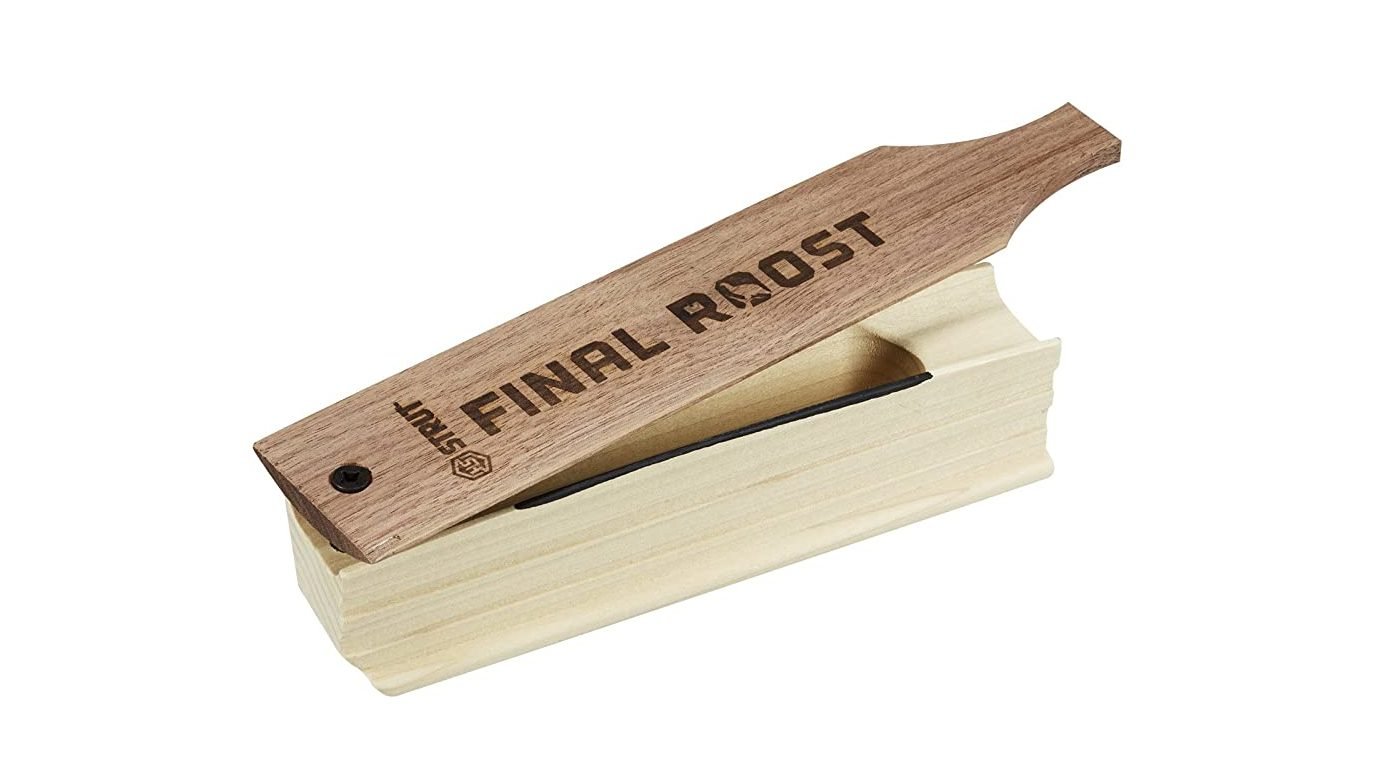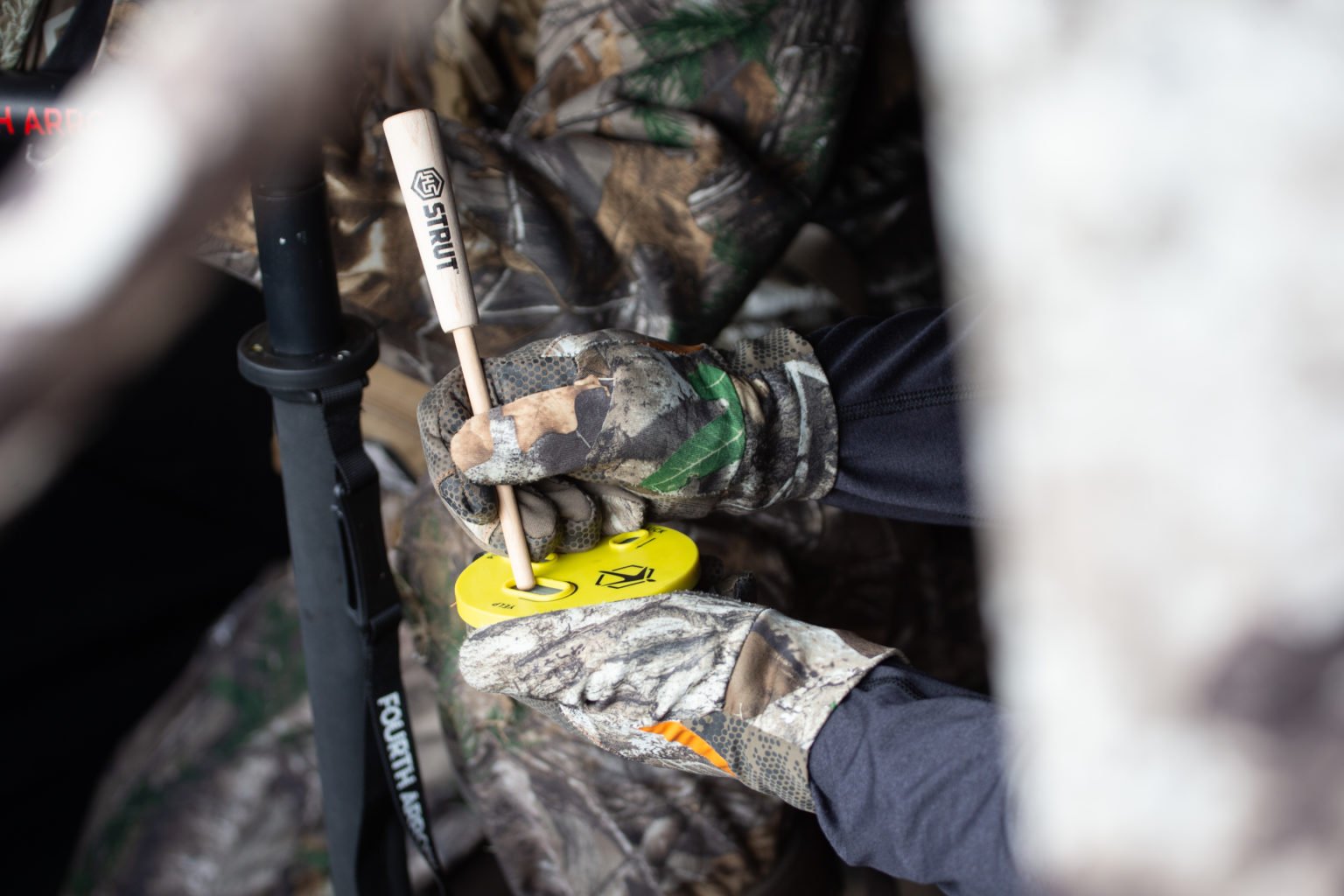Veteran turkey caller and accomplished hunter Mike Hanback gives us some helpful tips for turkey calling.
Since the mouth call is not affected by moisture—to the contrary, saliva on the reeds enhances its sound—the call is the best choice for rainy-day gobblers.
Mouth calls have been around for 150 years. Early diaphragms were big and crude, but modern calls are streamlined and high-tech, featuring either a latex or prophylactic reed crimped into an aluminum frame.
There are many mouth calls on the market. Some have one or two rubber reeds; others three or four.
Turkey hunting takes patience, skill, and the right gear. One of the most important pieces of equipment for calling in gobblers is a pot call. Also known as a slate call, pot calls produce realistic turkey sounds through friction when you drag a striker across the slate surface. With some practice, you can use turkey pot calls to mimic hen yelps, clucks, purrs, and more to interact with birds. This guide will teach you everything you need to know about how to use a turkey pot call correctly.
Parts of a Turkey Pot Call
A turkey pot call has three main components
-
Pot or cup – The bowl or cup of the call acts as a sound chamber. It’s often made of wood, plastic, or aluminum There are holes in the bottom to let sound out
-
Slate or calling surface – The slate sits inside the pot. It can be made of actual slate rock, glass, crystal, aluminum, or other metals. Each material sounds slightly different.
-
Striker – The striker is a short rod used to scrape across the slate surface to create friction and sound. Strikers are commonly wood, plastic, or pegstone.
Conditioning and Preparing Your Pot Call
Brand new pot call slates need to be conditioned before use by roughening up the surface. This creates microscopic grooves for the striker to catch on.
-
For soft slate surfaces, use 200 grit sandpaper or a Scotch Brite pad.
-
Harder surfaces like glass or metal need more abrasive 80-40 grit sandpaper.
-
Always scratch the surface in one direction, not swirling motions.
You can also lightly sand striker tips to remove buildup and keep sound crisp. Store calls covered indoors away from weather to prevent warping.
Proper Handling Technique
To get the best sound, you need to hold a pot call correctly:
-
Grip the outer edges between thumb and fingers. Don’t cover holes on bottom.
-
Keep slate clean and oil-free. Never touch bare handed.
-
Tilt striker at 45 degree constant angle, about 1 inch from tip.
-
Apply lighter pressure for high pitch, more for low raspy tones.
-
Find the slate’s “sweet spot” – often 1/3 in from outer edge.
Making Basic Turkey Sounds
With good technique, you can create various turkey calls by adjusting striker grip, pressure, and motion:
Yelps
-
Grip striker low, draw small dime-sized circles pressing down.
-
Make 3-5 circles about 1 second apart.
-
Bigger circles for pleading lost yelps.
Purrs
-
Grip striker higher to expose more length.
-
Lightly scrape striker in straight line towards you.
Clucks
-
Firmly press striker down while quickly pulling in.
-
Do single short strokes from same starting point.
Cuts
- Quickly repeat 5-6 cluck strokes in fast succession.
Cackles
- Add yelps and clucks then lighten pressure on cutting strokes.
Advanced Techniques
With ample practice, you can master more advanced pot call techniques:
-
Two-tone yelping – Alternate soft and loud yelps.
-
Clucking and purring – Insert clucks between purrs.
-
One-noted yelping – Make yelps same volume and pitch.
-
Rollercoaster yelping – Go loud-soft-loud with yelp pitch.
-
Fighting purr – Increase pace and crispness of purrs.
-
Plain yelping – Use only single note yelps, no variation.
Maintaining Your Pot Call
Follow these tips to keep pot calls performing their best:
-
Wipe dust and debris from slate surface gently with soft cloth.
-
Store in cool, dry place away from weather and humidity.
-
Replace strikers every 1-2 seasons as tips wear down.
-
If call gets wet, remove striker and dry thoroughly before storing.
With quality gear and regular practice, you’ll be expertly using turkey pot calls to bring in gobblers in no time! Let persistence and skill be your secret weapons this turkey season.

How to Slate Call
If you’re right-handed, hold a pot lightly in your left hand and up on your fingertips. Grasp a peg as if you were writing with a pencil.
Hold the call out in front of your body to keep from muting the sounds.
Hold a striker at a 45-degree angle to a call’s surface, and then run it lightly. Tweak the way you hold a peg to make the various calls.
Work a peg in the middle of a call’s surface to make deep clucks and yelps. Move the striker out to the edge for more trilling notes.
To create friction and make a call ring true, rub its surface frequently with an abrasive pad or sandpaper. Don’t forget to roughen the tip of a wooden striker from time to time.
Now, to make the key calls
- To cluck, place a peg on a pot, angle it slightly inward and pull a short stroke. Do not pick the peg off the surface; let it skip across the slate or glass. Put just a little pressure on the peg to cluck softly. Bear down harder for louder clucks.
- To cutt, serve up a series of fast, broken clucks. Bear down fairly hard on a peg and skip it over a call’s surface for five seconds or so, but again, don’t pick up the peg. There is no rhythm or cadence to cutting.
- To yelp, run a peg on a surface in straight lines or ovals. Make small ovals or short lines for soft yelps. Put a little more pressure on the peg and expand the ovals or lines for louder yelps.
- To cackle, string together some fast, raspy yelps. Finish up with a few reassuring clucks, like a hen makes once she flies down and hits the ground.
- To purr, exert just enough pressure on a peg so that it skips lightly over a call’s surface. Run little straight lines or make half-circles. Purring on a slate call is tough to beat for pulling a tom those last few yards into bow range.

An Arkansan named Gibson patented the first box call back in 1897. The big call has withstood the test of time and is still popular today.
Most long, rectangular boxes are crafted of wood—maple, cherry, walnut or poplar—and have free-swinging wooden handles or “lids.”
The box is a snap to use. Pick one up, fiddle with it for a few minutes and you’ll be talking good turkey.
How to Mouth Call
Place a diaphragm in your mouth with open reeds facing forward. Tongue the call up to the roof.
It shouldn’t sit too far forward or too far back in your mouth. Your tongue should touch the reeds and extend a half-inch or so to the front of the call.
If a mouth call feels too wide and bulky, trim the tape skirt a little. You can also bend the aluminum frame slightly downward to make the call fit more comfortably and create a better air seal.
Two major keys to using the diaphragm: First, don’t blow air across the reeds, but bring it up and “huff” from deep in your diaphragm.
And work your jaw up and down when you call, just like when you talk.
Now, to mock the hen vocalizations:
- To cluck, pop air across the reeds while saying the word “puck” or “putt”. While you might drop your jaw a bit, clucking is more about popping or smacking your lips.
- To cutt like a hen in spring, string together a series of sharp, fast and irregular clucks. Cutts have a staccato quality, with notes that go up and down. Vary the amount of air you force across a call’s reeds while popping your lips.
- To mock the two-note yelp of a hen, the bread-and-butter call you’ll use the most in either spring or fall, run a high note and a low note together. Say “chalk” while moving your jaw up and down. Practice a lot to get the speed and cadence of your yelps just right.
- To cackle like a hen flying down from the roost, string together some fast, excited yelps. Say “kit, kit, kit, kit, kat, kat, kat, kow, kow, kow” while running air rapidly across a call’s reeds.
- To kee-kee or whistle like a young turkey in fall, say the words “pee, pee, pee.” Pin a call tightly to the roof of your mouth to create a good air seal. Bring your lips tightly together and let the whistles come out. To roll into the kee-kee run, a call young gobblers make in fall, back up your “pee, pee, pee” with “chalk, chalk” yelps.
- To purr like a contented hen, pin a call to the roof of your mouth, push air up from your chest and flutter the back of your throat. Sound tough? Well, it is and some hunters have a devil of a time purring on a mouth call. Keep practicing until you get it. Or purr on a slate call.

Pot-and-peg calls have been around since the 1880s, and they are popular today. Early calls were crafted of wood or even turtle shells, with crude slate surfaces in the middle.
Modern calls have come a long way. Today you can use a finely machined wooden, plastic or graphite cup into which is glued a slate, glass, ceramic, aluminum or copper surface.
To talk turkey, strike a surface with a hickory, ash, rosewood, acrylic or carbon peg. This call is easy to use and sounds great.
Turkey Call Basics, Turkey Pot Call Tutorial!
FAQ
What is a pot call turkey?
Pot calls, often called slate calls, are friction-style calls that are easy to use and produce a range of turkey sounds.
What to say when using a turkey mouth call?
Mouth call: Begin with two yelps, then mouth the words “pit, pit, pat, pat, chalk, chalk chalk, chalk, chalk” as fast as you can, but slowing down a little on the last three notes. This takes some practice–and a super-fast tongue.
